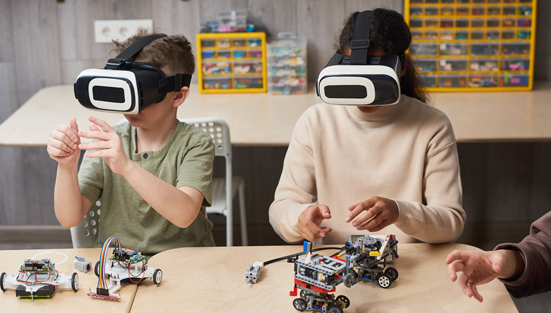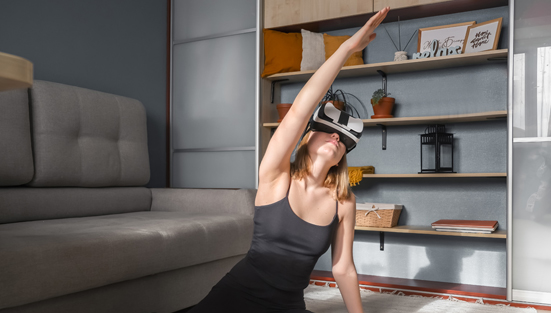Mixed Reality(MR) not a mixed bag…awe inspiring applications of MR!
Mixed Reality is the big advancement in computing after mainframes, personal computers, and mobile devices. Growing in popularity among consumers and enterprises alike, it offers the next level of experience by providing intuitive interactions with data in our living spaces and with our friends. Hundreds of millions of internet users have experienced mixed reality on their mobile devices. Mobile augmented reality (AR) is currently the most well-liked mixed reality option on social media. The use of Instagram AR filters by users may not even be recognised as mixed reality experiences. Mixed reality enriches all these experiences by providing users with stunning holographic representations of themselves, extremely realistic holographic 3D models of their surroundings, and the real world itself.

Cloud computing and artificial intelligence are all that is required to create a mixed reality experience; there are no physical restrictions or obstacles to worry about.
MR devices can interpret and store data in three dimensions thanks to sophisticated AI sensors, cameras, graphic processing units (GPU), and CPUs, including graphic cards and core chips. More advanced the gadget, better the mixed reality experience. Examples include smart gloves, body suits, eyewear, and cell phones. By connecting to a computer or a console through a wired or wireless connection, users of MR devices can gain access to software. This software allows the user to virtually place, replicate, or move objects around them, creating an immersive environment.
Modern mixed reality headsets like the HTC Vive or Meta Quest 2 are dissolving the line between reality and technology. To keep consumers interested in virtual interactions, these devices create high-fidelity environments.
Types of Mixed Reality devices
- Holographic devices
People who use holographic devices can get a semi-immersive experience with interactive virtual holograms. Examples of this type of technology are the Microsoft HoloLens, Magic Leap VR, and Google Cardboard. Using edge computing, users can create three-dimensional visualisations that can be saved, downloaded, and shared with others. They are often employed by professionals in factories or other manufacturing sites to give remote visual instruction for activities like putting together products, operating machinery, and inspecting the facility.
- Immersive devices
Immersive technology replaces the actual environment of the user with a simulated one that is experienced through a head-mounted display. This HMD has two near-eye displays, one for each eye, that are angled at 114 degrees to create a 3D experience. Further, these immersive devices have 6DoF, meaning users can move their body parts and look around without disrupting their experience. Two prime examples of immersive technology are Meta Quest 2 and Samsung Gear VR.
Use cases of Mixed Reality
Organizations are still testing out use cases and applications for their business processes because this invention is relatively new.
Marketing
Startups from a variety of industries are embracing immersive technology to increase their returns on investment (ROIs). Due to the fact that it allows customers to interact with products without using their hands, mixed reality has many applications in product marketing and advertising. Before making a purchase, customers can virtually try out and engage with a company's products or services using MR headsets.
Training
Mixed reality can be used to great effect in managing staff and training employees in any business. Companies like DHL, Xerox, and IBM are taking advantage of MR/VR training and upskilling programs to help their staff members progress. Through mixed reality, staff can collaborate with tutors in real-time to get training and save time.
Entertainment
The utilization of MR technology in events and entertainment can be quite awe-inspiring. The Weather Channel has been one of the pioneers to take advantage of this technology, permitting spectators to have a better view of weather conditions and preparing them to be ready for unpleasant weather. Although MR is a sophisticated technology, its uses in entertainment can be quite strange. A good illustration of this is the Angry Birds First Person Slingshot game, which utilizes Magic Leap headgear to animate the characters in the player's own environment.

Healthcare
MR simulations enable the visualization of human body parts in the form of holograms. It allows for the creation of 3D, interactive models of organs that can be explored by holding a mobile device over a specific spot. Its use in medical education has been very successful, as it is a powerful tool for training medical professionals, students, and even field medics. MR-enhanced X-ray vision can be used by radiologists to see through a patient's skin to locate bones and blood vessels. Mixed Reality has been shown to be very beneficial in emergency surgeries; its use has the potential to save lives.
Mixed Reality Wearable Computers
There are now virtually a limitless number of uses for them. They construct a digital display by mapping the actual physical surroundings around them. For example, you could reorganise the furnishings in a room without lifting a finger. In this use case for MR technology, digital applications are pinned where it makes the most sense. Consider keeping a to-do list next to your oven and a recipe app nearby. With this technology, multitasking is greatly enhanced!
About the FutureSkills Prime Programme:
FutureSkills Prime, a collaborative effort by nasscom and MeitY, serves as India's technology skilling hub with the objective of transforming the nation into a Digital Talent Nation. The program facilitates widespread access to learning, empowering both students and professionals to enhance their digital expertise and professional competencies. The comprehensive range of courses available through FutureSkills Prime encompasses a diverse array of digital technologies and vital professional skills.
Written by C-DAC Pune

